| Andes to Amazon | |||
| Ibike Ecuador | |||
| Dispatch 6 - Salasacas | |||
|
After
enjoying a couple of days mostly away from the Pan American, we had no choice but to rejoined the Pan Americana highway,
after Pujila, actually Latacunga. Several times the
roadside turned from rural to urban and back again. The biggest and
busiest town in route is Latacunga (a pre-colonial city favored by Incan
royalty because of its hot springs.) |
|||
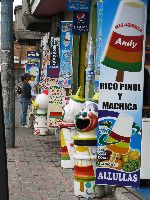 |
The town that is most
memorable is San Miguel de Salcedo, the self-proclaimed "Ice Cream Capitol of
Ecuador" -- we won't argue with that. Based on several conversations
with Ecuadorians since we left Quito, it seems to be a national tradition to stop for ice cream
in San Miguel de Salcedo when you are traveling the Pan Americana.
Where I don't recall see a single ice cream shop in other towns San Miguel de Salcedo
had dozens and dozens. It has more ice cream shops per
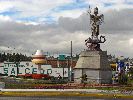 capita than any town I
have ever seen. They go so far as to have an ice cream cone sculpture at
the entrance to town (left). capita than any town I
have ever seen. They go so far as to have an ice cream cone sculpture at
the entrance to town (left).We obliged the tradition --"Hedalgo, the breakfast
of champions." (right) |
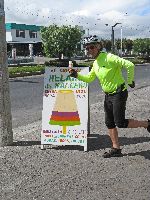 |
|
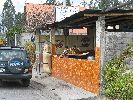 |
While San Miguel de Salcedo was all about ice cream, the next much smaller town, Pansaleo, was all about meat restaurants. There wasn't a single ice cream store in town, but there were a half dozen meat restaurants. It looks like more testing of the theory on the 'economy of agglomeration.' |
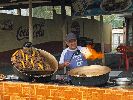 |
|
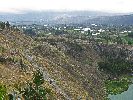 |
Between
the intermittent commercial areas there was a lot of open agricultural,
rural and natural areas. The Pan Americana was generally four lanes wide, with wide lanes and paved shoulders and not very crowded. Generally we didn't feel endangered, but at times it was loud and smelled of exhaust so less pleasant than the back roads -- unfortunately there are no practical alternative for this section. |
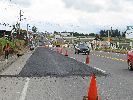 |
|
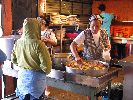 |
Along with the sparser population there is generally a dearth of restaurants along this section of road. Our timing for lunch was impeccable. We pulled into a restaurant with one empty table and no one was eating. After making some observations about what system was at play, we bought lunch tickets (less than $2) and sat down again. By this time it was standing room only. All of a sudden, in a flurry the serving began. We all got a large tasty bowl of soup. Good enough. We got our monies worth. But there is more. Next, we were presented with a plate of chicken, rice and salad. At twice the price that alone would have been a great deal. We not only were getting our monies worth, but we would be filled up. But there is more. A large glass of fruit juice followed. At least a $2 value by itself in the U.S., Canada and Europe. But there is more -- a tasty dessert. The large crowd seemed to come from an industrial area tucked in down an un assuming road across the highway. |
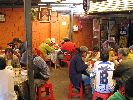 |
|
 |



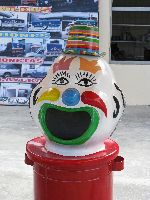 |
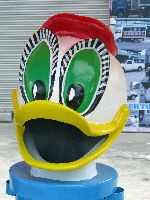 |
|
 |
A curious phenomenon between Latacunga and Ambato is clown and animal head garbage cans. There is a smattering of them all through the country, but I always seem to notice a higher concentration in this region of the central highlands. They are not just the same character painted uniquely. They almost all seem to be uniquely molded and different. There must be dozens of molds. It seems like a particularly labor intensive way to create something whose main purpose is to be filled with garbage. |
 |
|
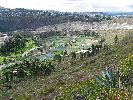 |
|
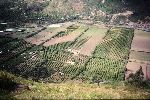 |
|
|
Being that Ambato is a miniature of Quito, leaving Ambato has some of
the same qualities as leaving Quito. We had been a little spoiled by the
low traffic volumes in the rural areas so there seemed like there was
a lot of traffic for a time, but it was nothing in comparison to
Quito.
Fifteen kiometers east is the small town of Salasaca. It is another of
Ecuador's pockets of indigenous culture. Unlike most other
places on the main road, there is still a strong tradition here of
both men and women continuing to wear traditional clothing
styles. There is also a traditional crafts market and for reason
that aren't apparent, other than a nice environment, there is a large
store selling bonsai. |
|||
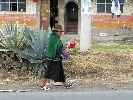 |
Salasaca is a historic center for weaving. In the 19th century their weavers wove fine wool textiles, waist bands and ponchos. Arriving in town the first indication is subtle but as you tune into the behavior you will start to see it almost everywhere -- women spin wool as they are walking, talking and otherwise passing time. Often the unspun wool is covered with a red handkerchief to keep it clean. |
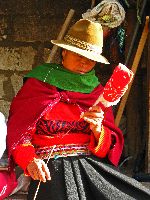 |
|
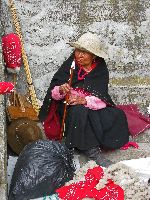 |
The art had almost died out by the mid twentieth century. The resurgence of weaving dates to 1957 or shortly there after. Through development programs and the formation of a cooperative the number of weavers started to grow. In the 1960s, Peace Corps volunteers recognized the value of the tradition and encouraged the weavers and helped increase sales. |
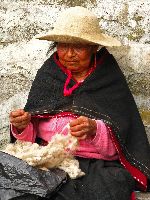 |
|
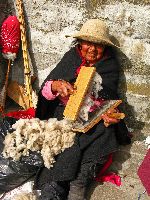 |
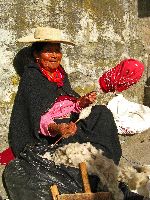
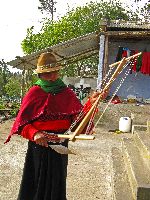
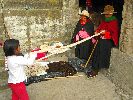 |
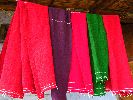 |
|
| A lot of the processing or preparing of the wool yarn is done at homes. The wool is cleaned (seed, grass and other foreign materials are picked out), carded (combed so the fibers are more aligned, parallel), spun (twisted in to yarn or thread), wind the yarn on a frame, twisted into a skein and then woven into fabric or items like ponchos and belts. Some of the wool is felted and formed into hats. | |||
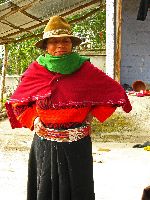 |
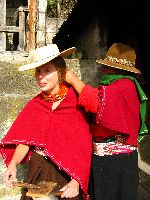
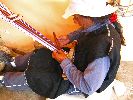
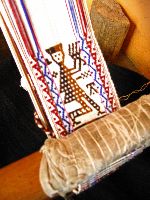 |
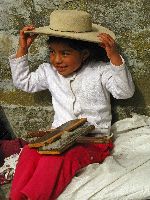 |
|
 |
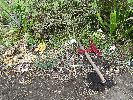 The Salasaca are descendents of the Inca, speaking Salasaca Highland Quichua.
It is said that here, the Incas came to ask their gods to improve their musical
ability and their voices so that they would be the best messenger among the
villages. There are several sacred places and shrines in the community
where people come to pray for health relationships and families, or to improve
there skills for an undertaking. The Salasaca are descendents of the Inca, speaking Salasaca Highland Quichua.
It is said that here, the Incas came to ask their gods to improve their musical
ability and their voices so that they would be the best messenger among the
villages. There are several sacred places and shrines in the community
where people come to pray for health relationships and families, or to improve
there skills for an undertaking. |
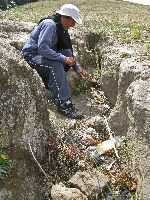 |
|
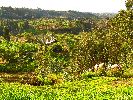 |
Another
economic foundation of Salasaca is agriculture; staples, vegetable, fruits,
berries, etc. Of the staple crops it is common to see the healthy practice
inter-cropping -- corn and beans grown together.
Local farmers are starting to grow agave, also know as a century plant. Chiefly Mexican, agaves are also native to the southern and western United States and central and tropical South America, but not the Andes highlands. With the expanding market for agave sweeteners the local farmers are looking at the economic viability of becoming producers. |
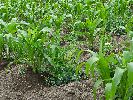 |
|
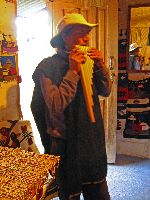 |
Our host and guide in Salasaca was Alonso Pilla. His resume includes being a pan pipe troubadour in Europe with an Ecuadorian band, master weave, innkeeper, cultural guide and village elder. It is in part fascinating to travel in the community with him because he know almost every body and has friends at every turn. |
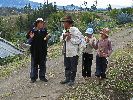 |
|
|
|
|||
   
|
|||
|
|
|||
|
"Hosted by
DreamHost - earth friendly web hosting"
|
|||
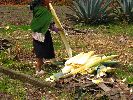
 Please
contact us
Please
contact us